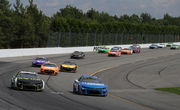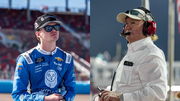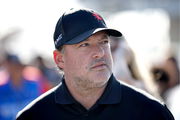
via Imago
NASCAR

via Imago
NASCAR
Over the years, NASCAR has introduced several rules and regulations to attract a broader audience and diversify its talent pool. The ‘Next-Gen Car’ was one such initiative, aimed at leveling the playing field and reducing costs for teams. Similarly, the introduction of stage racing in 2017 brought an element of strategy to the sport. Even the 2021 Dirt race at Bristol Motor Speedway was a bold experiment to reignite fan interest with a new racing format and this Food City Dirt Race was a treat to watch! NASCAR keeps adding initiative to always keep fans on the edge of their seats.
Recently, NASCAR unveiled yet another initiative: the Open Exemption Provisional (OEP). The rule allows a ‘world-class-driver’ from a different domain to race at a NASCAR event. Signed by 13 teams as part of last September’s charter agreement, the rule allows for the addition of a 41st car in select races. This provision makes its debut at the current Daytona 500, sparking debate across the industry. While the intention is to give non-NASCAR veterans an opportunity, its implementation has left some questioning its fairness, as currently witnessed at the ongoing Daytona event.
ADVERTISEMENT
Article continues below this ad
Johnson and Truex Jr. play spoilsport for NASCAR’s stunt as Castroneves’ fate hangs on controversial rule
Qualifying for the Daytona 500 brought both clarity and controversy. NASCAR veterans Martin Truex Jr. and Jimmie Johnson secured their spots in the race by locking in on speed. They clocked 181. 302 mph and 180.785 mph respectively. This left motorsports legend Helio Castroneves in a precarious position, but can still participate in the race, thanks to the OEP rule. It allows NASCAR to expand the starting grid to 41 cars for select races. Designed to attract high-profile drivers from other disciplines, it gives non-NASCAR full-timers a chance to enter the race without qualifying on speed. But, the rule has its own benefits and drawbacks.
The non-NASCAR winner will surely be awarded the race win, the trophy, and an All-Star Race eligibility. But, it misses out on the good parts from the thrill of victory. This includes, missing out on the prize money, not getting an opportunity to participate in the play-off, and most importantly, not scoring Championship points for the win. Castroneves, driving the No. 91 Chevrolet for Trackhouse Racing, can be the first potential beneficiary of this rule at Daytona.
Despite his impressive motorsport resume, Castroneves didn’t secure a qualifying spot with his lap of 50.069 seconds. He’ll compete in the Duels to earn his place. But if he fails there too, the OEP rule could still grant him entry. Despite criticism, NASCAR officials have compared it to the ‘promoter’s choice’ provision in short-track racing, where race organizers reserve a spot for marquee drivers.
Helio Castroneves ran a lap of 50.069s. Castroneves won’t get into the Daytona 500 on the strength of his lap. He will either have to race his way in through the Duel or fall back on his provisional (which would make the field 41 cars, instead of 40). #NASCAR | #Daytona500
— Jonathan Fjeld (@Jonathan_Fjeld) February 13, 2025
Veteran driver Denny Hamlin has been vocal about his disapproval, calling the rule a “desperate move” by NASCAR to bring attention to the sport. He said that it’s unfair to the drivers who have to fight their way in on speed. Critics argue that it compromises the integrity of the competition, especially when accomplished drivers like Jimmie Johnson and Martin Truex Jr. must qualify the traditional way.
What’s your perspective on:
Is allowing non-NASCAR stars like Castroneves fair, or does it disrespect seasoned drivers like Truex Jr.?
Have an interesting take?

USA Today via Reuters
Feb 25, 2024; Hampton, Georgia, USA; NASCAR Cup Series driver Daniel Suarez (99) battles with NASCAR Cup Series driver Ricky Stenhouse, Jr (47) and NASCAR Cup Series driver Martin Truex, Jr. (19) during the Ambetter Health 400 at Atlanta Motor Speedway. Mandatory Credit: David Yeazell-USA TODAY Sports
While some see the rule as an exciting way to attract outside talent, others believe it compromises the sport’s competitive integrity. Castroneves remains focused on the race ahead, acknowledging that the rule is controversial but also emphasizing that he’s ready to use the rule to get a seat in the Daytona 500. “If I have to take it, I’ll take it,” he said. But, there remains another way to get an upper hand. Even though he cannot score championship points, Justin Marks’ new driver can still make use of the ‘Fastest Lap rule.‘ Maybe, NASCAR will come up with special provisions for the Indy Car champion of 2021. But, with OEP instated in the sport, new opportunities dawn upon what could have been a very interesting battle of old favorites.
ADVERTISEMENT
Article continues below this ad
Trending
More problems ahead for NASCAR over the OEP rule
While the Open Exemption Provisional (OEP) rule aims to bring global motorsports stars into NASCAR, it also raises serious concerns about fairness and consistency. If multiple high-profile drivers apply for the same event, NASCAR must decide who gets the coveted 41st spot. According to the charter, the position is intended for a driver who will ‘significantly impact the promotion of the event and grow the prominence of the sport.’
This vague criterion leaves plenty of room for controversy. In a recent media briefing, NASCAR was asked how it would handle requests from multiple world-class drivers. Imagine Lewis Hamilton, Max Verstappen, Scott Dixon, and Jimmie Johnson all applying for the same race. The decision-making process would inevitably spark debates about favoritism, fairness, and what qualifies as ‘promoting the sport.’
ADVERTISEMENT
Article continues below this ad
The challenge may not be far off. With NASCAR heading to Mexico City later this year, rumors are already swirling about Juan Pablo Montoya’s potential return. The problem could escalate if more high-profile drivers seek entry through the OEP rule. If legends like Lewis Hamilton, Max Verstappen, or Scott Dixon express interest, NASCAR faces tough decisions on who qualifies as the “world-class driver” deserving of the 41st spot.
How will NASCAR handle this growing dilemma without compromising competition? Only time will tell.
ADVERTISEMENT
ADVERTISEMENT
ADVERTISEMENT
ADVERTISEMENT







Is allowing non-NASCAR stars like Castroneves fair, or does it disrespect seasoned drivers like Truex Jr.?